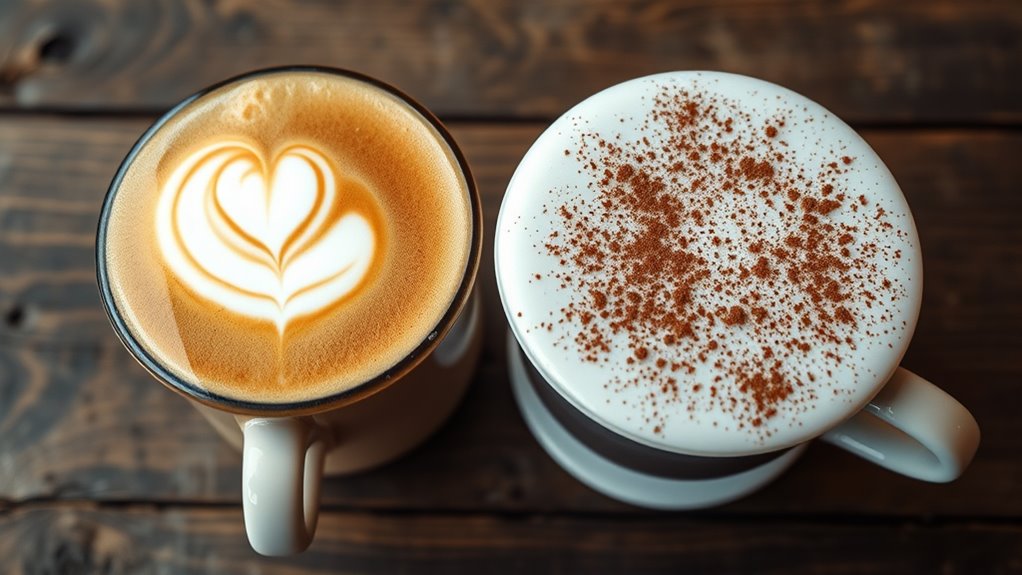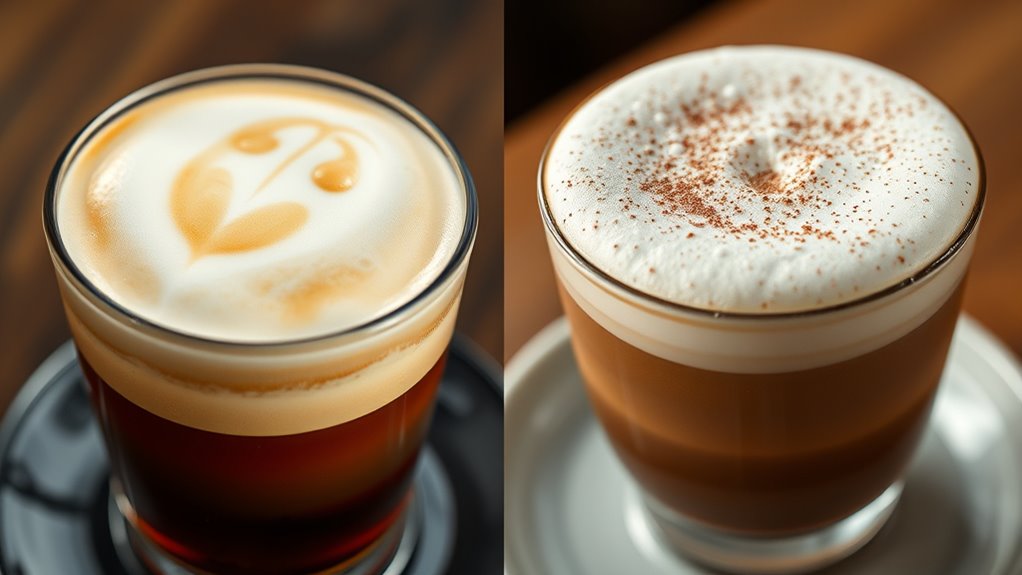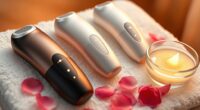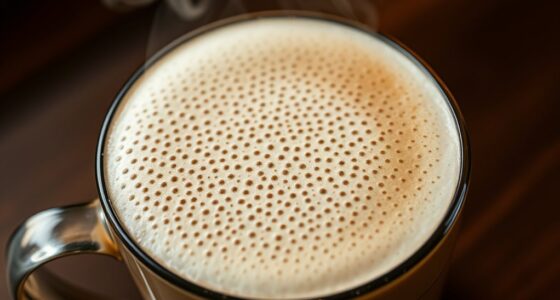A wet cappuccino has smooth, microfoamed milk blending seamlessly with espresso, creating a creamy and mellow flavor. In contrast, a dry cappuccino features a thicker foam cap that sits on top, highlighting the bold, concentrated espresso flavor. The texture and milk-to-espresso ratio shape the overall taste and experience. If you want to explore how these differences influence flavor and texture, keep going to get the full scoop.
Key Takeaways
- Wet cappuccino features microfoamed, smooth milk blending into espresso, creating a velvety texture and milder flavor.
- Dry cappuccino has thicker, stable foam that sits atop the espresso, emphasizing strong coffee flavors.
- The proportion of milk is higher in wet style, resulting in a creamier, softer taste, while dry style has less milk for a more intense coffee experience.
- Foam acts as a barrier in dry cappuccino, trapping rich espresso flavors, whereas microfoamed milk in wet style blends seamlessly.
- Overall, wet cappuccinos are milder and creamier, while dry versions offer a bolder, more robust coffee flavor.

Have you ever wondered what distinguishes a wet cappuccino from a dry one? The key difference lies in the milk texture and how it interacts with the espresso, which ultimately affects the flavor profiles you experience with each drink. When you order a wet cappuccino, you’re getting a beverage with a higher proportion of steamed milk, resulting in a creamier, more velvety texture. The milk in a wet cappuccino is microfoamed but still fluid enough to blend smoothly with the espresso, creating a harmonious balance. This blend results in a softer, milder flavor profile, where the richness of the milk enhances the coffee without overpowering it. The increased milk volume softens the bitterness of the espresso, making the overall taste more mellow and accessible, especially if you prefer a less intense coffee experience.
On the other hand, a dry cappuccino emphasizes the espresso shot with just a thin layer of froth on top. The milk texture here is lighter, with a thicker, more stable foam that stands above the espresso rather than blending into it. When you sip a dry cappuccino, the flavor profiles are more concentrated and robust, highlighting the bold, roasted qualities of the espresso. Because there’s less milk to dilute the coffee, the bitterness and complexity of the espresso shine through more clearly. This makes dry cappuccinos ideal for those who enjoy a stronger coffee flavor and appreciate the distinct aroma and taste of well-extracted espresso. The foam acts as a barrier, trapping the espresso’s intense flavors and delivering a more intense sensory experience with each sip.
Understanding these differences can help you choose the right style based on your mood or preference. If you’re craving something smooth and comforting, a wet cappuccino’s milk texture and balanced flavor profile will satisfy that desire. Conversely, if you want a more pronounced coffee taste with a thicker foam cap, a dry cappuccino is your go-to. The proportions of milk to espresso directly influence the overall experience, so knowing what to expect can elevate your appreciation for this classic espresso-based drink. Additionally, the milk texture in each type plays a crucial role in how the flavors are perceived, making it an important factor to consider when ordering. Whether you prefer the creamy harmony of a wet cappuccino or the bold intensity of a dry one, recognizing how milk texture and flavor profiles interplay will help you order with confidence and truly enjoy every sip.
Frequently Asked Questions
Can I Customize a Wet or Dry Cappuccino at Any Coffee Shop?
Yes, you can usually customize a wet or dry cappuccino at most coffee shops. Simply talk to your barista about your flavor preferences and ask for specific amounts of foam or milk. Barista customization allows you to tailor your drink to your liking, whether you prefer a creamier texture or a stronger coffee flavor. Don’t hesitate to communicate your preferences clearly for the perfect cappuccino experience.
Which Type of Cappuccino Has More Caffeine Content?
You might think dry cappuccinos pack more caffeine, but it actually depends on the espresso shot used, not the foam ratio. Usually, both wet and dry cappuccinos have similar caffeine content since they use the same espresso amount. However, the flavor profile varies: wet cappuccinos are creamier, while dry ones offer a stronger coffee taste. So, your caffeine intake stays consistent, but your flavor experience changes.
Are Wet or Dry Cappuccinos Healthier Options?
Wet cappuccinos are generally healthier options because they contain more milk, offering added health benefits like calcium and vitamins. They tend to have fewer calories compared to dry cappuccinos, which focus on more foam and less milk. If you’re mindful of calorie intake, a wet cappuccino might be better. However, both can be enjoyed in moderation as part of a balanced diet.
How Do I Order a Wet or Dry Cappuccino Correctly?
To order a wet or dry cappuccino, specify your espresso preference and milk foam ratio. For a dry cappuccino, ask for extra foam and less milk, emphasizing a “dry” style. For a wet cappuccino, request more steamed milk with a thinner layer of foam. Clearly communicate your desired milk foam ratio, and the barista will prepare it accordingly. Be specific to guarantee you get the perfect cappuccino tailored to your taste.
Do Wet or Dry Cappuccinos Taste Better?
You might find wet cappuccinos taste better if you enjoy a richer, creamier flavor contrast, while dry ones offer a more intense coffee flavor with a frothy texture difference. Don’t worry—taste is subjective, so try both to see which suits your preference. The wetter version provides a smoother mouthfeel, perfect if you love milk, whereas the dry offers a bold, airy experience. Experiment to discover your favorite!
Conclusion
So, next time you order a cappuccino, remember that the choice between wet and dry isn’t just about taste—it’s about your style. You might think you’re in control, but really, you’re just along for the ride, swayed by foam or liquid. Ironically, whether you prefer it wet or dry, you’re still chasing that perfect sip. So, enjoy the illusion of choice, because in the end, it’s all just coffee—beautifully unpredictable and wonderfully personal.









